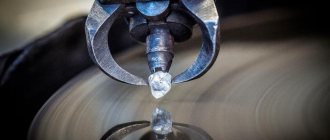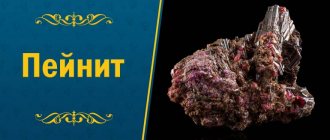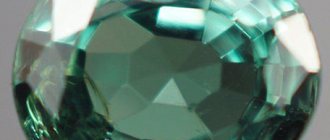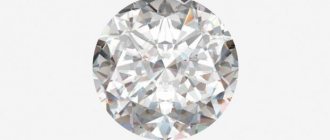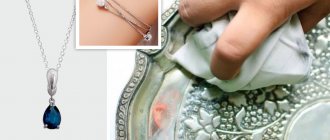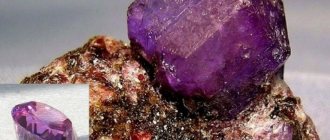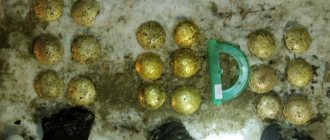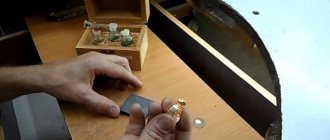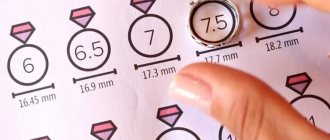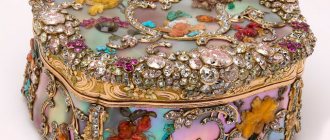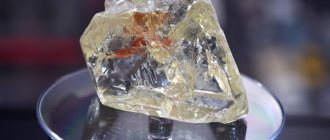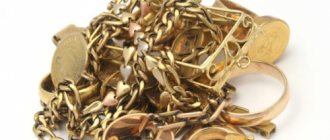Checking a gemstone for authenticity, as a rule, involves checking the jewelry stone (insert) for compliance with the information stated during the sale and purchase.
When checking the authenticity of a stone, it is necessary to confirm the declared mineral type and variety, the nature of origin, the presence or absence of refining, and also to determine the quality characteristics of the declared ones.
How to distinguish a real stone from a fake
Often, determining the material and origin of a jewelry insert is difficult due to setting, and then it is necessary to use a set of available determination methods, both direct - determining the diagnostic constants of minerals, and indirect - allowing one to judge the mineral type indirectly.
Diagnosis of a mineral species in the simplest case is carried out on the basis of measured optical-structural constants of minerals, but subject to limited access (including for visual inspection), additional methods are used, such as:
- thermal conductivity research;
- electrical conductivity study;
- study of magnetic properties;
- study of the nature of various types of luminescence.
In minerals partially accessible to visual observation, the following methods are used:
- study of the appearance of internal microinclusions;
- examination of the surface (its defects and individual characteristics);
- study of the nature of pleochroism;
- study of the nature of birefringence;
- investigation of internal structural anomalies.
When determining organic jewelry stones and diamond, in addition to measuring optical constants, Raman and luminescence spectroscopy, the infrared spectroscopy method is used to identify characteristic carbon-containing compounds.
Such different semi-precious stones
For many centuries, semi-precious stones have been one of the most popular jewelry inserts. The amazing colors and properties of these crystals, as well as their reasonable price, allowed them to decorate both simple, uncomplicated products and jewelry masterpieces. In addition, this type of stone is widely used in exquisite ornaments.
Semi-precious stones: how to identify?
But, in fact, what stones do we consider semi-precious?
There is no single answer to this question. In fact, the name used by everyone is not a definition. In various sources we can find different conventional classifications of such stones.
Firstly, semi-precious minerals include those minerals that are quite common in nature and so diverse that their price is significantly lower than the price of rare precious stones
Secondly, this is the name given to those stones that are intensively used in the jewelry industry, as well as in the manufacture of ornamental works.
In addition, the classification of this category of minerals is often based on the hardness scale known in jewelry production. In this case, everything is simple: the harder the crystal, the higher the value of the jewel.
So, let's summarize. Semi-precious stones are minerals that are very popular in jewelry, but are not classified as expensive gems. By the way, according to the law of the Russian Federation “On Precious Metals and Precious Stones”, only diamond, blue sapphire, ruby, emerald, alexandrite and natural pearls are considered rare in Russia. It follows from this that, according to the law, all other jewelry stones are semi-precious or, as they are sometimes called, ornamental.
Favorite Gems
Why have semi-precious stones earned such love from jewelers and buyers?
The main physical properties of these stones include high hardness and, therefore, ease of cutting. This is why jewelers value them so much.
Semi-precious stones are in great demand among buyers due to their varied color palette (from crystal white to deep purple) and transparency. At the same time, their attractive appearance is favorably combined with accessibility, which makes them particularly popular. Until now, many jewelry houses give preference to semi-precious stones when creating their collections.
Choose yours
The most famous and popular semi-precious stones are amethyst, aquamarine, garnet, rock crystal, topaz, peridot, and citrine. After cutting, these stones become transparent and especially attractive. Therefore, in the hands of experienced jewelers, minerals acquire a unique shine and become an ideal addition to any piece of jewelry.
In addition to attractive external characteristics, semi-precious minerals are usually endowed with a number of interesting properties.
Thus, amethyst is considered a symbol of sincerity, sincerity and peacefulness. Amethyst lifts the mood, gives vigor and relieves stress.
Aquamarine is the stone of the brave, the patron of travelers and enthusiasts. Aquamarine has the ability to encourage action, which is why it is often given to lazy people. Since ancient times in Europe, newlyweds exchanged rings with aquamarine, which brings love and mutual respect to the family.
Pomegranate brings joy to its owner, gives self-confidence and increases self-esteem. This is a special stone, a stone of love, flame and passion. Pomegranate promotes creativity, therefore it is considered a talisman for people in creative professions.
Rock crystal helps stimulate mental activity, improves emotional mood and has a beneficial effect on the general condition of its owner.
Topaz is rightfully considered the most mysterious of all semi-precious minerals. This is a stone of exposure, penetration into the essence of something. Products with topaz are recommended to be worn by psychologists and criminologists. It awakens mental strength and gives emotional balance.
Rauchtopaz has a similar name, but different properties. This gem is considered to be a stone of calm and contemplation. It is often worn by people trying to get rid of depression.
Peridot brings love and peace to its owner. Chrysolite is considered to be the stone of successful people, leaders of their business. Since ancient times, chrysolite inserts have always been adorned with the products of merchants, merchants and businessmen.
Citrine will help improve the mood of its owner and set him in an optimistic mood. In addition, citrine helps to achieve good results in cooperation and partnership, and to correctly express your thoughts. Therefore, jewelry with citrine is recommended to be worn by students, students, and all business people.
Ametrine is a fairly rare mineral, which received this name due to its similarity with amethyst and citrine. A special two-color stone has a positive effect on mood and makes a person more friendly.
Jewelers also use apatite, which is called the “stone of peace,” as inserts. It is believed that the mineral absorbs the energy of its owner, so it is not recommended to re-gift products with apatite.
Products with quartz are recommended to be worn by people who want to make new acquaintances, make friends, establish existing contacts - that is, all those who want to get rid of loneliness.
Aventurine is considered one of the varieties of quartz. It is not for nothing that its name is translated as “connected with the occasion.” It is believed that the stone brings good luck to those people whose activities are associated with constant risk and uncertainty. Therefore, the stone is recommended to be worn by athletes, as well as creative people seeking inspiration.
Fairy stones
Not everyone knows that semi-precious stones also include such stones as agate, turquoise, onyx, malachite, jade, jasper and amber. It seems that these are names from old fairy tales or antiquity, pulled out of a dusty box. And such associations are not accidental.
It turns out that these semi-precious minerals became famous precisely thanks to ornaments. Chic interior items and antique decorative elements were made from these stones. I immediately remember the unique amber room of the Catherine Palace, the malachite box of the Mistress of the Copper Mountain from the fairy tale by P. Bazhov, the jade rosary from the book of the same name by B. Akunin.
These semi-precious stones are quite large in size, so they most fully realize their natural potential. Since ancient times, special magical properties have been attributed to them in different countries. For example, in China jade was called nothing less than the stone of life. Jasper has long been especially valued in Japan. Russia has always been considered the empire of amber (94% of this mineral is mined in our country), and turquoise was especially popular in the Middle East and Central Asia.
Products made from semi-precious stones have always been at the peak of popularity, and our time is no exception. Fashion dictates new forms, but traditions remain unchanged.
Features of checking a gemstone for authenticity
Determining the quality characteristics is best done for a stone that is in loose form, since when assessing the parameters of a stone installed in a piece of jewelry, a significant error may occur. This error is minimal and does not exceed 5% in weight and 1 group of color and clarity for a stone with high quality cutting characteristics, set in the most open setting. But if the quality of the stone cut deteriorates, and it is set in a frame that impairs viewing and the ability to take measurements, and has mirrored, matte or colored surfaces, the error may increase.
Comparison of natural and synthetic minerals
Synthetic minerals are stones grown in a laboratory using chemical components. That is why many jewelry lovers use this type of mineral, due to its low price and noble appearance. Of course, the fact of the presence of an artificial component must be disclosed to the buyer. Certified jewelry stores are unlikely to break the law and offer a natural one under the guise of a synthetic mineral. But if the purchase occurs at small points, then the likelihood of counterfeiting doubles.
There are three types of stones:
- precious - a natural material, has durability, attractiveness (brilliance, color, optical effects): diamond, ruby, sapphire, natural pearls;
- semi-precious - other stones of natural origin: aquamarine, turquoise, tourmaline, opal, crystal, amber, others;
- ornamental - a natural material with an opaque structure that is less durable, unlike other types of stones: agate, carnelian, cat's eye and others.
Classified by origin:
- natural;
- synthetic;
- imitation.
Counterfeit ones, in turn, are divided into:
- synthetic – precious stones artificially grown in laboratory conditions;
- high-quality fakes;
- imitations made of glass, plastic.
You can distinguish by several factors:
- price;
- visually;
- physical properties;
- structure.
Precious stones are divided into 3 types: first, second and third order, and a separate type is ornamental
Differences in price
Reference. One of the main differences between natural stone and synthetic stone is cost. In many ways, the price of a natural product depends on the rarity of its presence in nature. If the jewelry is in perfect appearance and condition, without defects, then the cost increases several times. The advantage of synthetic materials is their quality characteristics, unlike natural stones, and their low price for almost the same chemical composition. The pricing policy depends not only on the origin of the mineral, but on the cutting process and its methods.
The cost of artificial stones ranges from 1 cent to $150, depending on the stone; without cutting, the price does not exceed $10. Precious natural minerals are valued much higher - from $10 to $100 without cutting. Cut stones of natural origin cost at least $100 and reach the figure of $30,000, this difference depends on the quality and size of the mineral.
Visually distinguishable parameters
When buying jewelry, it will be very difficult for a person who does not understand the intricacies of the work of jewelry craftsmen to distinguish a fake by eye. Optical properties are an important factor in determining the authenticity of a natural stone. They mean color, shine, sparkle, transparency, cloudy or not, iridescence, and other light effects. You can distinguish a precious stone from a non-precious one using ultraviolet light. Artificially grown ones have a bright glow, unlike natural ones.
Physical properties
Minerals in the physical sense are distinguished by the properties of density, hardness, and cleavage:
- Density is the determination of the ratio of the mass of a stone to the volume of water. With a density below two - light, from 2 to 4 - normal, from 5 and above - heavy. Precious minerals have a density of 1-7.
- Hardness is a determination of the ability of a stone to scratch the surface or damage the mineral itself. Most natural minerals have a hardness of 8 to 10 on the Mohs hardness scale.
- Cleavage is the ability to split, split into equal parts. Cleavage occurs due to the structure of the crystal lattice, as well as the cohesion of atoms in different planes.
Stone structure
The structure of stones includes determining the chemical composition, size and shape of the crystal. Thanks to the unique chemical composition, natural rocks are durable. The sizes of natural stones are small, with rare exceptions. Artificial stones can reach any size. The form of the natural can be very complex and difficult to process. The chemical composition of the minerals is almost the same, with the exception of fakes. Almost all fakes are made of glass. For diamonds, metallic foil or mercury is used. Amber and agate are counterfeited with plastic, turquoise with porcelain.
Where to check the authenticity of gemstones
Nowadays, every year new technologies are developed and existing technologies for the synthesis and refining of jewelry stones are improved, as a result of which a standard set of gemological equipment for determining a jewelry insert, the nature of its origin and the availability of possible refining methods is not enough.
Therefore, the most reliable way to make sure that your jewelry stones comply with the data declared by the seller is to contact a specialized gemological laboratory, where specialists using professional equipment will diagnose the properties of your stone and answer all your questions.
Author of the publication: I. Yantarny
What stones imitate
Imitation is usually made of glass with plastic additives. These materials are used to create carnelian, chrysoprase, turquoise and others. Glass and stone combinations are also used. You can distinguish stone from glass with the naked eye.
The following materials are used for simulation:
- natural materials of low quality;
- artificially grown stones;
- glass materials;
- plastic;
- crystals that have been pressed.
Real stones are rare among costume jewelry, since the difference between natural and imitation stones is sometimes too pronounced, and such jewelry is unlikely to be popular.
It is almost impossible to identify a gemstone on your own, so it is better to turn to specialists or experienced appraisers.
What stones cannot be faked
There is no point in counterfeiting stones that are not popular, there are thousands of them in nature, are not precious, and also have minimal cost.
There are practically no valuable stones left in nature that scientists cannot imitate. Precious, which are very rare, polychrome varieties of stones are not imitated. It is difficult to achieve a specific crystal color as the difference will be obvious. Many ornamental stones are very difficult to imitate, such as agates and alexandrites.
Basic recommendations to follow when purchasing
When buying jewelry with precious stones, in order not to be deceived, it is recommended to do the following:
- Every normal store should have a book of complaints and suggestions. It is advisable to pay attention to it and review it, since from what is written you can draw conclusions about the reputation of the store;
- It is recommended to carefully study the product tag. All information provided on it must be understandable. If something is suspicious, you should contact the seller or consultant with questions;
- Don’t be shy to ask a lot of questions about the characteristics of the purchase you are interested in. You need to ask the seller a question about the origin of the jewelry, is it natural or synthetic. In the case of natural stone, it is worth asking whether the stone has been subjected to any processing;
- You must urgently ask the seller for a receipt with a list of all the characteristics. This will be important evidence in court if the purchase turns out to be fake.
Experts advise remaining vigilant when making custom jewelry. Jewelers can discreetly slip in synthetic quality instead of natural stone. In this case, you need to ask the jeweler for a receipt detailing the color, size and other important characteristics.
An examination that will determine the authenticity of the jewelry
In order to avoid purchasing counterfeit jewelry with stones, it is recommended to conduct a gemological examination. At its first stage, the gemstone is identified, and then the jewelry is examined to prove its authenticity or artificial origin. After completing the first stage, experts determine the quality of the stone. Gemological examination does not imply finding out the real value of the stone; it is already established by the market, and consists of many components.
It is no secret that the examination of jewelry is not profitable for manufacturers and sellers. Sellers believe that the buyer is not spoiled and will buy what is offered to them. In most cases, experienced experts are approached by buyers who, when purchasing a gemstone, have doubts about its authenticity or the reputation of the store or suppliers.
Also, a common reason for turning to experts is the purchase and sale procedure. In this case, it is necessary to evaluate the jewelry that the owner received as an inheritance or whether the jewelry is exclusive because it was made to order.
There are frequent cases of fraud in other countries. Local sellers pass off fakes as real stones, in the hope that tourists will not have time to spot the fake and will not return to exchange it.
Some calls to experts are related to how the owner behaves with the jewelry. In such cases, the decision is made in favor of the sellers. For example, there was a situation where a woman bought jewelry with opals. She took him with her on vacation and was constantly with him, she sunbathed and swam with him. As a consequence, the stones changed their color. She decided that she had been deceived in the store and did an examination. It turned out that some types of stones can be chemically unstable and change their color when exposed to chemical elements. Thus, in order not to have to once again turn to the services of experts, it is recommended that when purchasing, you study the rules of behavior with this stone.
How to recognize fake turquoise
For example, beads made of natural turquoise cannot cost 20-30 dollars, since the price of this mineral even for one gram will be significantly higher. But, really, this is if we talk about the so-called. precious turquoise, which is almost impossible to see on sale in modern products. This turquoise is extremely sensitive. The mineral itself is quite porous, so it reacts rather poorly to excess moisture, lotions or creams. He also does not like very dry air and bright rays of the sun. In general, natural turquoise is more durable than pearls, but not too much.
Semi-precious turquoise is even less resistant to external damage. Its density is lower and its color is less even than that of precious stone. It accounts for more than 80% of the production of this mineral. In order to improve the color of turquoise and extend its life, it is stabilized. Most often, they are impregnated with wax to enhance the brightness and strength of the stone.
The cheapest variety of natural turquoise is pressed. It is obtained from stone chips mixed with resins and dye. Formally, such a stone can be considered natural, since it is made from the same mineral. Pressed turquoise is the brightest and most durable. It is this gem that is most often found in modern jewelry. But, despite the cheapness of the pressed variety, you can still find many fakes on the market.
Turquoise is imitated with plastic, glass, ceramics and cheaper minerals. And if glass is easy to recognize by its characteristic ringing, and plastic by trying to pierce a stone with a hot needle, then with other imitations it is somewhat more difficult.
It is worth paying attention to the size of the stone. A natural turquoise bead cannot be larger than 5 millimeters. However, pressed stone can have larger sizes. Then you need to look at the holes in the stone (if we are talking about beads). They should not be white on the inside. You can also try scratching the gem. If you fail, you are looking at earthenware, glass or another mineral harder than turquoise. If, on the contrary, the stone is easily damaged, but a whitish mark remains at the site of the scratch, or the layer is separated by a light powder, this is a painted fake. If you try to scratch a bead or cabochon, shavings will form - your “turquoise” made of plastic. All these manipulations should be done from the reverse side of the stone. In our country, dyed howlite is often sold under the guise of turquoise. In nature, this mineral is gray in color. It is softer and lighter than turquoise and also has a more vitreous luster.
Main characteristics of synthetic stones
In order to distinguish natural jewelry from a fake, you need to know their features. To this end, we will consider the main characteristics of synthetic stones.
- Diamonds. Today there are changes for the better in the field of growing jewelry diamonds. The main difference between a natural diamond and a laboratory diamond is that inclusions of other minerals can be observed in a natural stone.
- Sapphires and rubies. Today, a large number of different methods for growing sapphires and rubies have already been invented. Most of these stones presented on the jewelry market were obtained using the Vernelle method. They differ from others in that they have curved zonation lines (this is not the case in natural stones). In some cases, they may have air bubbles.
- Emerald. These stones are grown using the same methods as rubies and sapphires. The characteristic qualities of emerald are inclusions of brown iron oxide, inclusions of a tubular shape and zoning in size and color. There are specimens that do not have these features. In such a situation, they are analyzed by other methods.
- Quartz. The most common representative of this group of stones is amethyst, which is obtained hydrothermally. It is quite sought after as it is very similar to its natural counterpart. The only thing that distinguishes them is the various inclusions, but it is not always possible to recognize where the fake is. Most often they turn to experts who study it using special methods.
Tags that carry false information
Price criterion is one of the most important when identifying jewelry. But even experienced jewelers make mistakes in this matter, not to mention those people who decide to purchase jewelry for the first time in their lives. It is also not correct to assume that the sellers are to blame, since when receiving the goods, they evaluate the goods superficially and read the information on the tags. For example, a situation happened in one of the jewelry stores when a new batch of jewelry was brought to them. These were silver jewelry with blue stones inserted. People who accepted the goods, after examining the appearance of the stone, found it difficult to determine its name. The tag said it was a sapphire. But in fact it turned out to be ordinary glass of high quality processing. Some unscrupulous sellers indicate “virgin sapphire” on the tag, instead of “synthetic sapphire”. The abbreviation "grown" implies grown. From the side of the law, everything is fair and there is nothing to pester; an inexperienced buyer in this matter may not pay attention to this or may not know and will be deceived. The International Confederation of Homology has fixed the main possible names and abbreviations. But since these standards are advisory in nature, in some countries they do not listen to them and write false information on labels.
One of the signs of synthetic stone is its neat appearance.
In the world of fakes, there are various types of imitation for real stones. For example, a stone such as turquoise is most often sold on the jewelry market in pressed form. It is made by sintering natural fine crumbs. Under natural conditions, real jewelry grows in the form of ordinary threads, and if you manage to find large thread sizes, they will cost a lot of money. If someone decides to buy jewelry with a turquoise element, then it is recommended to pay vigilance to the color of the precious rarity and its structure. Turquoise with pronounced inclusions of various minerals and those that have uneven coloring are more valued. Buyers should be suspicious of the absolute purity and uniform color of turquoise, since in nature such a phenomenon is quite rare or even impossible.
